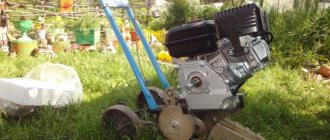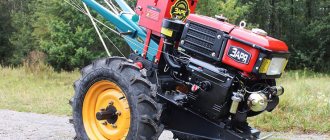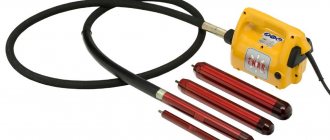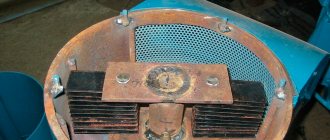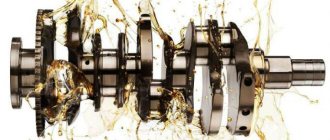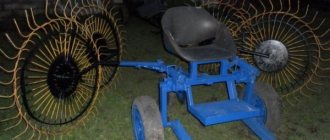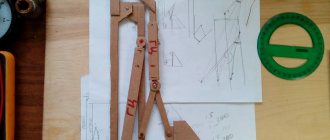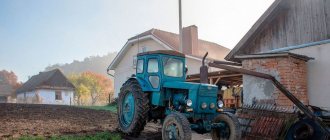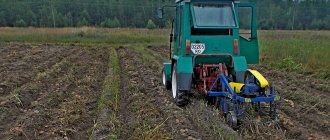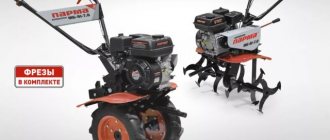Among gardening equipment there is a special category - powerful field workers who can cope with the most difficult work. Today we’ll talk about walk-behind tractors and what you can turn a familiar unit into using attachments.
To cultivate large plots of land that exceed standard country plots, as well as small farms, you need good multifunctional equipment. Let's talk about how to choose the most productive and at the same time economical option. In this case, it is best to opt for a walk-behind tractor. It turns out that he can do almost all gardening work. In addition, he can combine them perfectly.
For a land plot of 15 acres, a walk-behind tractor with a power of 3-4 hp is sufficient, 20-30 acres - 4-5 hp. etc.
Motoblock device
The design of walk-behind tractors is almost the same, regardless of the brand of walk-behind tractor. The walk-behind tractor consists of such components as: engine, chassis, transmission and controls. Below is a diagram of the MTZ-05 walk-behind tractor
Motoblock structure (MTZ-05):
1. Magneto 2. Muffler 3. Air cleaner 4. Carburetor 5.22 Rod and throttle control lever 6. Gas tank 7.13 Rod and differential lock lever 8. Power take-off lever 9.11 Rod and gear shift lever 10 Steering column 12. Gear shift lever 14. Clutch lever 15. Cable 16. Trailer bracket 17. Hitch 18. Control column 19. Fuel pump 20. Lever 21. Nut for fixing the vertical installation of the steering column.
Assembly tools
- One of the main tools that is needed to create a walk-behind tractor is, of course, a welding machine. Welding involves almost all devices for a do-it-yourself walk-behind tractor.
- Basic tools needed for plumbing. Among which there are hacksaws with files, and various taps suitable for different threads.
- Despite the fact that many fasteners are made by welding, you will still need a screwdriver or drill.
- Measuring tools should also be available, with which you can always check compliance with the sketch.
- Fasteners: nuts, bolts, self-tapping screws.
- Screwdrivers.
Motoblock engine design
As a rule, walk-behind tractors are equipped with a classic internal combustion engine. Most walk-behind tractors have a four-stroke gasoline engine, while heavier models have diesel engines. There are walk-behind tractors, usually lightweight, of low power, with two-stroke engines installed.
Design of a four-stroke gasoline engine:
1. Forged crankshaft 2. Fuel filters 3. Air filter 4. Electronic ignition 5. Cylinder 6. Valves 7. Support ball bearing.
A single-cylinder four-stroke gasoline engine consists of the following main components and systems: Crank mechanism, gas distribution mechanism, fuel supply system, control system, lubrication system, air supply and exhaust gas exhaust system, starting system, ignition system and cooling system. This information will be useful when repairing the engine.
The transmission is designed to transmit rotating motion from the engine to the wheels and change the direction and speed of movement. The transmission consists of the following components: gearbox, differential, as well as gearbox and clutch (in some models).
The purpose of the differential is to ensure that the right and left wheels rotate at different speeds to improve maneuverability.
By type, transmission organs (gearboxes and transmissions) can be belt, gear and chain.
What is a walk-behind tractor?
In the understanding of many summer residents, a walk-behind tractor is often identified with a cultivator. In fact, these are completely different types of technology. A walk-behind tractor is more of a type of mini-tractor. Its engine has greater power compared to cultivators (5-20 horsepower), which allows the walk-behind tractor to use wheels on an axle as a propeller. With enough power it can be used as a vehicle. In addition, various attachments can be used for this type of equipment.
Skilled summer residents turn a walk-behind tractor into a vehicle
Motoblock gearbox design
The gearbox is designed to change the gear ratio and transmit rotation from the gearbox pulley to the wheels. Below is a diagram of the gearbox.
Gearbox device:
1. Shaft 2. Bearing cover 3. Gearbox housing 4. Intermediate shaft 5. 6. Sprocket block 7. Intermediate shaft 8. Chain 9. Sprocket block 10. Intermediate shaft 11. Chain 12. Oil drain plug 13. Shift knob 15. Input shaft 16. Input sprocket 17. Chain 18. Nut 19. Chain 20. Chain 21. Radial ball bearing.
Gearbox device
The gearbox is used to change speeds, which can be up to 6 forward and up to 2 reverse.
The chassis is a frame on which the wheels and main components of the walk-behind tractor are mounted.
The walk-behind tractor controls include gear shift rods, steering column, clutch control levers, gas control, etc.
Source
Types of additional equipment
Tillage
Milling cutters. The most popular type of attachment for walk-behind tractors. Designed for cultivation of different types of soil. Every gardener and farmer faces the need to cultivate soil. And often special equipment is purchased primarily for the purpose of performing this operation. By removing and adding sections, you can obtain the required cultivation width.
Plows. If it is necessary to carry out plowing rather than cultivation, it is better to use a plow. It is recommended to use it when processing large areas and previously uncultivated areas (virgin lands). When plowing with a conventional plow, after plowing the furrow, it is necessary to drive the machine back idle. The process can be optimized using a reversible plow , which provides the ability to plow in two directions - forward and backward. A hiller plow with a V-shaped share will help make furrows for sowing vegetables and hill up potato beds after planting.
Harrow. To break up large clods of earth, remove stones and weeds that remain after plowing with a plow, you can use a harrow - a toothed, disk or rotary harrow.
Potato digger. Digging up potatoes is one of the most labor-intensive and difficult garden jobs. The potato digger attachment allows you to quickly, easily and without damaging the tubers to harvest potatoes. The potato digger's share plunges under the root crops, and the moldboards allow the soil to fall down, leaving the tubers on top.
Mowing grass and making hay
Mower. The main tool for cutting grass is a mower. Mowers for walk-behind tractors can be blade or rotary. A blade (segment) mower is more maneuverable and allows you to work in hard-to-reach places, between bushes and trees. A rotary mower is more efficient in operation and provides high productivity.
Cleaning work.
Rotary brush. If you need to quickly and efficiently clean a large area, use your walk-behind tractor and rotary brush. Such equipment can be used for cleaning asphalt surfaces, paving slabs, paths, as well as for removing freshly fallen snow.
Blade knife. This attachment is also called a bulldozer knife. By connecting a bulldozer blade to a walk-behind tractor, you can move large piles or heaps effortlessly. For example, sand, gravel or snow. Please note that such equipment can only be connected to sufficiently powerful models of walk-behind tractors that can cope with high loads.
Auger-rotary snow blower. The same snow blower, only powered by your walk-behind tractor. The steel toothed auger easily breaks even icy snowdrifts. The distance and direction of throwing snow masses can be adjusted.
Cargo transportation
Trailers. A cargo trailer (cart) allows you to use a walk-behind tractor to transport cargo weighing from 300 to 500 kg. Such trailers are usually folding for easy and quick unloading. The adapter trailer is a frame with a seat to which additional equipment can be attached via the rear hitch. The seat provides the operator with the necessary comfort while working.
Other options
Weighting agent. If the walk-behind tractor has a small mass, it must be weighted to increase traction. Weights are attached to the car body or wheels. Weighting the wheels is considered more effective.
Turner. A special attachment for high-quality and uniform drying of hay. It is a fork with a rotation mechanism.
Motor pump. An effective tool for pumping water from tanks, ponds, and flooded basements in private and municipal households.
Potato planter. This device makes it possible to significantly simplify and speed up the process of planting potatoes. Essentially, it is a container with planting material that moves on wheels. A special mechanism itself digs a furrow, immerses the root crop and covers it with soil.
Seeder. It works on the principle of a potato planter. Only instead of tubers, vegetable seeds are sown in the furrows.
Repair instructions for the gearbox on a walk-behind tractor
You shouldn’t start repairing the gearbox on a walk-behind tractor yourself if the operation of the unit and its design are a complete secret to a new user. Since the gearbox is a rather complex unit, you should not proceed to repairing it yourself immediately after detecting breakdowns. It will be better if professionals handle the repair of the gearbox.
If an oil leak is detected from the gearbox, it means that the bearing seals were installed incorrectly or were worn out. They may not be properly tightened on the lids. Damaged gaskets may appear underneath them. If the air valve (breather) is clogged, it is necessary to clean it and bring the oil level to normal. Oil leaks can be eliminated by replacing or correctly installing oil seals or gaskets. Tightening the cover bolts will also help solve the problem.
Basic materials
Considering different options for how to make a walk-behind tractor with your own hands, you will notice that the most common recommendation is to use engines from old motorcycles or mopeds.
But in addition to this main component, you will need several more elements, which include a steel pipe used as a frame.
It is also worth stocking up on a sheet of iron. The casing, as well as body parts, are made from it. The axis, which will be in the supporting structure, is made either from a strong steel rod or from a pipe.
The equipment will not be able to function without wheels with tires with the widest possible tread.
Among others, gearboxes, bearings, and transmission elements stand out. When creating a Neva walk-behind tractor with their own hands, owners, as a rule, want to minimize costs.
To do this, before starting design, it is necessary to evaluate what is available; perhaps the elements useful for such equipment are lying idle in the garage.
Types of violations in the checkpoint and ways to correct them
If the automatic transmission mechanism has stopped functioning normally, the following types of problems may occur:
If the kinematic connection inside the gearbox is broken or the sprocket in the block breaks, it is necessary to disassemble the gearbox to replace the problematic sprocket. The cause of an oil leak on the shift shaft may be excess oil in the gearbox, so you need to check the oil level. If the welding connection of the gear breaks, disassemble the gearbox and replace the block shaft. After draining the excess oil, you should check the degree of wear of the working edge of the cuff on the shift shaft, disassemble the gearbox and replace the part.
The reason for the lack of gear locking or their spontaneous shutdown is a violation of the adjustment of the gear shift mechanism. When making repairs, you should loosen the screws securing the switching mechanism board.
After this, engage first gear and tighten the screws securing the board. For example, having made a mini tractor with your own hands, it is imperative to ensure that the drive is adjusted correctly by changing the tension of the axle axle separation control cable. To correct the breakdown of any element of the axle decoupling drive inside the gearbox, you should disassemble the gearbox and replace the broken parts.
If a broken spring or worn shift mechanism board retainers are found, the damaged parts should be replaced by adjusting the gear shift. If it is missing, the shift crayon may be destroyed or the threaded piece of the shift knob may be cut off. After disassembling the gearbox, it will be necessary to replace the defective parts. If there is no gear shift, you should disassemble the gearbox and replace the worn gear shift fork. If the cause of the gearbox jamming is a broken chain, then it should be disassembled and the chain replaced.
Homemade trailer
A trailer can be made in several ways and using different materials. As a rule, homemade structures are made from a metal frame and wood.
Procedure:
- Make a carrier consisting of a drawbar and a rotating body. Connect to the frame so that the hinge is inside the tubular body.
- Make the frame according to pre-drawn drawings from a pipe with a diameter of 60 mm. Sheath it with wood or metal sheet.
- Using a solid metal axle, install car wheels on the structure.
- Assemble a driver's seat from wood.
The tailgate of the trailer is hinged to facilitate loading and unloading. Metal reinforcements are welded on the sides. The trailer is painted and connected to the walk-behind tractor.
Troubleshooting Tips
If the operation of the gearbox is accompanied by increased noise in the gearbox, then the reason for this may be a lack of oil in the gearbox device or a discrepancy between the quality of the lubricant and the required parameters. It is necessary to choose oils of the appropriate brand; they must have a certain purity. If there are any problems, you will need to change the oil or add it to the gearbox.
The occurrence of noise in the transmission units of a walk-behind tractor can be caused by loose fasteners, so it is necessary to inspect the fasteners, tightening them properly.
The cause of frequent noise is wear of the gears and bearings. This may lead to more serious damage to the walk-behind tractor's gearbox. It is not difficult to avoid their occurrence if you carry out timely inspection and repair of the walk-behind tractor. It consists of the usual replacement of worn components and parts.
Walk-behind tractor equipment and power
It is important to understand that any additional equipment that is connected to the walk-behind tractor increases the load on the engine. Exactly how much it increases depends on its type and operating principle. The greatest power is required by stationary equipment (plow, harrow, ploughshare, etc.). Mechanical and mixed (mower, cutters, potato digger, etc.) create less load, but work productivity will still depend on power. Therefore, when choosing a walk-behind tractor, be sure to study what additional equipment can be used with a specific model. The manufacturer always indicates this in the accompanying technical documentation.
